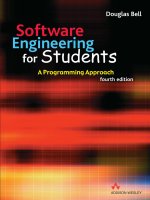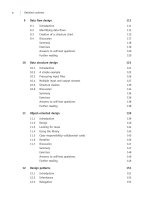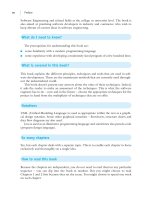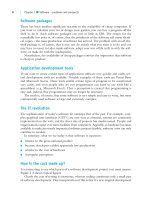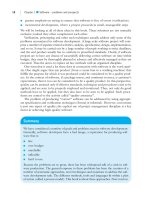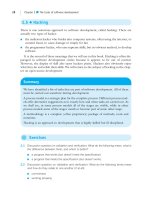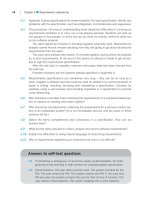Software Engineering For Students: A Programming Approach Part 30 potx
Bạn đang xem bản rút gọn của tài liệu. Xem và tải ngay bản đầy đủ của tài liệu tại đây (160.19 KB, 10 trang )
268 Chapter 19 ■ Testing
We begin this chapter by discussing the general problem of testing – and discover
that there is a significant problem. We consider approaches called black box and white
box testing.
There are a whole number of associated testing techniques, which we outline.
The problems of testing large pieces of software that consist of many components
are severe – particularly if all the components are combined at one and the same time.
It would be convenient to know how errors arise, because then we could try to avoid
them during all the stages of development. Similarly, it would be useful to know the
most commonly occurring faults, because then we could look for them during verifica-
tion. Regrettably, the data is inconclusive and it is only possible to make vague state-
ments about these things.
Specifications are a common source of faults. A software system has an overall
specification, derived from requirements analysis. In addition, each component of
the software ideally has an individual specification that is derived from architectural
design. The specification for a component can be:
■ ambiguous (unclear)
■ incomplete
■ faulty.
Any such problems should, of course, be detected and remedied by verification of
the specification prior to development of the component, but, of course, this verifica-
tion cannot and will not be totally effective. So there are often problems with a com-
ponent specification.
This is not all – there are other problems with specifications. During programming,
the developer of a component may misunderstand the component specification.
The next type of error is where a component contain faults so that it does not meet
its specification. This may be due to two kinds of problem:
1. errors in the logic of the code – an error of commission
2. code that fails to meet all aspects of the specification – an error of omission.
This second type of error is where the programmer has failed to appreciate and cor-
rectly understand all the detail of the specification and has therefore omitted some nec-
essary code.
Finally, the kinds of errors that can arise in the coding of a component are:
■ data not initialized
■ loops repeated an incorrect number of times.
■ boundary value errors.
19.2
●
The nature of errors
BELL_C19.QXD 1/30/05 4:25 PM Page 268
19.4 Black box (functional) testing 269
Boundary values are values of the data at or near critical values. For example, suppose
a component has to decide whether a person can vote or not, depending on their age.
The voting age is 18. Then boundary values, near the critical value, are 17, 18 and 19.
As we have seen, there are many things that can go wrong and perhaps therefore it
is no surprise that verification is such a time-consuming activity.
We now explore the limitations of testing. Consider as an illustration a method to cal-
culate the product of its two integer parameters. First, we might think of devising a
selection of test data values and comparing the actual with the expected outcome. So we
might choose the values 21 and 568 as sample values. Remembering negative numbers,
we might also choose –456 and –78. If we now look at possible coding for the proce-
dure, we can immediately see the drawback with this approach:
public int product(int x, int y) {
int p;
p = x * y;
if (p == 42) p = 0;
return p;
}
The problem is that, for some reason – error or malice – the programmer has cho-
sen to include an
if statement, which leads to an incorrect value in certain cases. The
test data that was chosen above would not reveal this error, nor, almost certainly, would
any other selection of test data. Thus use of selective test data cannot guarantee to
expose bugs. Now it could be argued that the bug is obvious in this example – simply
by looking at the program. But looking at a program is not testing – it is a technique
called inspection that is discussed later in this chapter.
A second method of testing, called exhaustive testing, would be to use all possible
data values, in each case checking the correctness of the outcome. But even for the
method to multiply two 32-bit integers would take 100 years (assuming a 1 millisec-
ond integer multiply instruction is provided by the hardware of the computer). So
exhaustive testing is almost always impracticable.
These considerations lead us to the unpalatable conclusion that it is impossible to test
any program exhaustively. Thus any program of significant size is likely to contain bugs.
Knowing that exhaustive testing is infeasible, the black box approach to testing is to
devise sample data that is representative of all possible data. We then run the program,
input the data and see what happens. This type of testing is termed black box testing
because no knowledge of the workings of the program is used as part of the testing –
we only consider inputs and outputs. The program is thought of as being enclosed
19.4
●
Black box (functional) testing
19.3
●
The problem of testing
>
>
BELL_C19.QXD 1/30/05 4:25 PM Page 269
270 Chapter 19 ■ Testing
within a black box. Black box testing is also known as functional testing because it uses
only knowledge of the function of the program (not how it works).
Ideally, testing proceeds by writing down the test data and the expected outcome of
the test before testing takes place. This is called a test specification or schedule. Then
you run the program, input the data and examine the outputs for discrepancies between
the predicted outcome and the actual outcome. Test data should also check whether
exceptions are handled by the program in accordance with its specification.
Consider a program that decides whether a person can vote, depending on their age
(Figure 19.1). The minimum voting age is 18.
We know that we cannot realistically test this program with all possible values, but
instead we need some typical values. The approach to devising test data for black box
testing is to use equivalence partitioning. This means looking at the nature of the input
data to identify common features. Such a common feature is called a partition. In the
voting program, we recognize that the input data falls into two partitions:
1. the numbers less than 18
2. the numbers greater than or equal to 18
This can be diagrammed as follows:
Figure 19.1 The voting checker program
0 17 18 infinity
There are two partitions, one including the age range 0–17 and the other partition
with numbers 18 to infinity. We then take the step of asserting that every number with-
in a partition is equivalent to any other, for the purpose of testing this program. (Hence
the term equivalence partitioning.) So we argue that the number 12 is equivalent to
any other in the first partition and the number 21 is equivalent to any number in the
BELL_C19.QXD 1/30/05 4:25 PM Page 270
19.4 Black box (functional) testing 271
We have reasoned that we need two sets of test data to test this program. These two
sets, together with a statement of the expected outcomes from testing, constitute a test
specification. We run the program with the two sets of data and note any discrepancies
between predicted and actual outcome.
Unfortunately we can see that these tests have not investigated the important distinction
between someone aged 17 and someone aged 18. Anyone who has ever written a program
knows that using
if statements is error prone, so it is advisable to investigate this particu-
lar region of the data. This is the same as recognizing that data values at the edges of the
partitions are worthy of inclusion in the testing. Therefore we create two additional tests:
1 12 cannot vote
2 21 can vote
Test number Data Outcome
3 17 cannot vote
4 18 can vote
Test number Data Outcome
first number: 0 54 10,000
second number: 0 142 10,000
In summary, the rules for selecting test data for black box testing using equivalence
partitioning are:
1. partition the input data values
2. select representative data from each partition (equivalent data)
3. select data at the boundaries of partitions.
In the last program, there is a single input; there are four data values and there-
fore four tests. However, most programs process a number of inputs. Suppose we
wish to test a program that displays the larger of two numbers, each in the range
0–10,000, entered into a pair of text boxes. If the values are equal, the program dis-
plays either value.
Each input is within a partition that runs from 0 to 10,000. We choose values at
each end of the partitions and sample values somewhere in the middle:
Now that we have selected representative values, we need to consider what combi-
nations of values we should use. Exhaustive testing would mean using every possible
combination of every possible data value, but this is, of course, infeasible. Instead, we
use every combination of the representative values. So the tests are:
second. So we devise two tests:
BELL_C19.QXD 1/30/05 4:25 PM Page 271
272 Chapter 19 ■ Testing
This form of testing makes use of knowledge of how the program works – the struc-
ture of the program – as the basis for devising test data. In white box testing every state-
ment in the program is executed at some time during the testing. This is equivalent to
ensuring that every path (every sequence of instructions) through the program is exe-
cuted at some time during testing. This includes null paths, so an
if statement with-
out an
else has two paths and every loop has two paths. Testing should also include
any exception handling carried out by the program.
Here is the Java code for the voting checker program we are using as a case study:
public void actionPerformed(ActionEvent event) {
int age;
age = Integer.parseInt(textField.getText());
if (age >= 18) {
result.setText("you can vote");
}
19.5
●
White box (structural) testing
1000
2 0 142 142
3 0 10,000 10,000
454054
5 54 142 142
6 54 10,000 10,000
7 10,000 0 10,000
8 10,000 142 10,000
9 10,000 10,000 10,000
Test number 1st number 2nd number Outcome
SELF-TEST QUESTION
19.1 In a program to play the game of chess, the player specifies the desti-
nation for a move as a pair of indices, the row and column number. The
program checks that the destination square is valid, that it is not out-
side the board. Devise black box test data to check that this part of the
program is working correctly.
Thus the additional step in testing is to use every combination of the (limited) rep-
resentative data values.
>
BELL_C19.QXD 1/30/05 4:25 PM Page 272
19.5 White box (structural) testing 273
else {
result.setText("you cannot vote");
}
}
In this program, there are two paths (because the if has two branches) and there-
fore two sets of data will serve to ensure that all statements are executed at some time
during the testing:
>
1 12 cannot vote
2 21 can vote
Test number Data Expected outcome
3 17 cannot vote
4 18 can vote
Test number Data Expected outcome
If we are cautious, we realize that errors in programming are often made within the
conditions of
if and while statements. So we add a further two tests to ensure that
the
if statement is working correctly:
Thus we need four sets of data to test this program in a white box fashion. This hap-
pens to be the same data that we devised for black box testing. But the reasoning that
led to the two sets of data is different. Had the program been written differently, the
white box test data would be different. Suppose, for example, the program used an array,
named
table, with one element for each age specifying whether someone of that age
can vote. Then the program is simply the following statement to look up eligibility:
result.setText(table[age]);
and the white box testing data is different.
SELF-TEST QUESTION
19.2 A program’s function is to find the largest of three numbers. Devise
white box test data for this section of program. The code is:
int a, b, c;
int largest;
➞
BELL_C19.QXD 1/30/05 4:25 PM Page 273
274 Chapter 19 ■ Testing
Stepping through code
Some debuggers allow the user to step through a program, executing just one instruc-
tion at a time. This is sometimes called single-shotting. Each time you execute one
instruction you can see which path of execution has been taken. You can also see (or
watch) the values of variables. It is rather like an automated structured walkthrough.
In this form of testing, you concentrate on the variables and closely check their val-
ues as they are changed by the program to verify that they have been changed correctly.
A debugger is usually used for debugging (locating a bug); here it is used for
testing (establishing the existence of a bug).
19.6
●
Other testing methods
if (a >= b) {
if (a >= c) {
largest = a;
}
else {
largest = c;
}
}
else {
if (b >= c) {
largest = b;
}
else {
largest = c;
}
}
19.3 In a program to play the game of chess, the player specifies the desti-
nation for a move as a pair of integer indices, the row and column num-
ber. The program checks that the destination square is valid, that is, not
outside the board. Devise white box test data to check that this part of
the program is working correctly.
The code for this part of the program is:
if ((row > 8) || (row < 1)) {
JOptionPane.showMessageDialog(null, "error");
}
if ((col > 8) || (col < 1)) {
JOptionPane.showMessageDialog(null, "error");
}
BELL_C19.QXD 1/30/05 4:25 PM Page 274
19.6 Other testing methods 275
Testing the test data
In a large system or program it can be difficult to ensure that the test data is adequate.
One way to try to test whether it does indeed cause all statements to be executed is to
use a profiler. A profiler is a software package that monitors the testing by inserting
probes into the software under test. When testing takes place, the profiler can expose
which pieces of the code are not executed and therefore reveal the weakness in the data.
Another approach to investigating the test data is called mutation testing. In this
technique, artificial bugs are inserted into the program. An example would be to
change a + into a –. The test is run and if the bugs are not revealed, then the test data
is obviously inadequate. The test data is modified until the artificial bugs are exposed.
Team techniques
Many organizations set up separate teams to carry out testing and such a team is some-
times called a quality assurance (QA) team. There are, of course, fruitful grounds for
possible conflict between the development group and the QA team.
One way of actually exploiting conflict is to set up an adversary team to carry out
testing. Such a team is made up of what we might normally think of as being anti-social
people – hackers, misfits, psychotics. Their malice can be harnessed to the effective dis-
covery of bugs.
Another approach is to set up bounty hunters, whose motivation for finding errors is
financial reward.
Other techniques for collaborative working are explained in Chapter 20 on groups.
Beta testing
In beta testing, a preliminary version of a software product is released to a selected mar-
ket, the customer or client, knowing that it has bugs. Users are asked to report on faults
so that the product can be improved for its proper release date. Beta testing gets its name
from the second letter of the Greek alphabet. Its name therefore conveys the idea that it
is the second major act of testing, following on after testing within the developing organ-
ization. Once Beta testing is complete and the bugs are fixed, the software is released.
Automated testing
Unfortunately this is not some automatic way of generating test data. There is no magical
way of doing that. But it is good practice to automate testing so that tests can be reapplied
at the touch of a button. This is extra work in the beginning but often saves time overall.
Regression testing
An individual test proceeds like this:
1. apply a test
2. if a bug is revealed, fix it
BELL_C19.QXD 1/30/05 4:25 PM Page 275
276 Chapter 19 ■ Testing
3. apply the test again
4. and so on until the test succeeds.
However, when you fix a bug you might introduce a new bug. Worse, this new bug
may not manifest itself with the current test. The only safe way to proceed is to apply
all the previous tests again. This is termed regression testing. Clearly this is usually a for-
midable task. It can be made much easier if all the testing is carried out automatically,
rather than manually. In large developments, it is common to incorporate revised com-
ponents and reapply all the tests once a day.
Formal verification
Formal methods employ the precision and power of mathematics in attempting to ver-
ify that a program meets its specification. They place emphasis on the precision of the
specification, which must first be rewritten in a formal mathematical notation. One such
specification language is called Z. Once the formal specification for a program has been
written, there are two alternative approaches:
1. write the program and then verify that it conforms to the specification. This
requires considerable time and skill.
2. derive the program from the specification by means of a series of transformations,
each of which preserve the correctness of the product. This is currently the favored
approach.
Formal verification is very appealing because of its potential for rigorously verifying
a program’s correctness beyond all possible doubt. However, it must be remembered
that these methods are carried out by fallible human beings, who make mistakes. So
they are not a cure-all.
Formal verification is still in its infancy and is not widely used in industry and com-
merce, except in a few safety-critical applications. Further discussion of this approach is
beyond the scope of this book.
When we discussed black box and white box testing above, the programs were very
small. However, most software consists of a number of components, each the size of a
small program. How do we test each component? One answer is to create an environ-
ment to test each component in isolation (Figure 19.2). This is termed unit testing. A
driver component makes method calls on the component under test. Any methods that
the component uses are simulated as stubs. These stubs are rudimentary replacements
for missing methods. A stub does one of the following:
■ carries out an easily written simulation of the mission of the component
■ displays a message indicating that the component has been executed
■ nothing.
19.7
●
Unit testing
BELL_C19.QXD 1/30/05 4:25 PM Page 276
19.8 System (integration) testing 277
Thus the component under test is surrounded by scaffolding. This is a large under-
taking. In many developments, the collections of drivers and stubs is often as big as the
software itself.
Thus far we have only considered unit testing – testing an individual software compo-
nent, a method or a class. We have implicitly assumed that such a component is fairly
small. This is the first step in the verification of software systems, which typically con-
sist of tens or hundreds of individual components. The task of testing complete systems
is called system or integration testing.
Suppose that we have designed and code all the components for a system. How can
we test these components and how can we test the complete system?
Here are three different approaches to system testing:
1. big bang – bring all the components together, without prior testing, and test the
complete system
2. improved big bang – test each component individually (unit testing), bring them
all together and test the complete system
3. incremental – build the system piece by piece, testing the partial system at each
stage.
The first approach – big bang or monolithic testing – is a recipe for disaster. There is
no easy way of knowing which component is the cause of a fault, and there is an enor-
mous debugging task. The second approach is slightly better because when the com-
ponents are brought together, we have some confidence in them individually. Now any
faults are likely to be caused by the interactions between the components. Here again,
there is a major problem of locating faults.
An alternative is to use some form of incremental testing. In this approach, first one
component of the system is tested, then a second component is linked with the first
and the system tested. Any fault is likely to be localized either in the newly incorpo-
rated component or in the interface between the two. We continue like this, adding
just one component at a time. At each stage, any fault that presents itself is likely to be
caused by the new component, or by its interface to the system. Thus fault finding is
19.8
●
System (integration) testing
Stub
Stub
Stub
Driver
Component
under test
Figure 19.2 Unit testing
BELL_C19.QXD 1/30/05 4:25 PM Page 277

